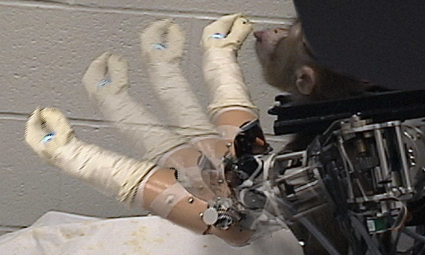Monkey’s brain controls robotic arm
Last updated Jun 17, 2008 — 1931 views Scientists at the University of Pittsburgh have demonstrated a robotic arm being operated by a monkey’s brain activity. Signals transmitted by a microcontroller implanted in the monkey’s brain enable the animal to robotically feed itself pieces of fruit in an effortless and natural manner.
Scientists at the University of Pittsburgh have demonstrated a robotic arm being operated by a monkey’s brain activity. Signals transmitted by a microcontroller implanted in the monkey’s brain enable the animal to robotically feed itself pieces of fruit in an effortless and natural manner.

Photo sequence showing the monkey feeding itself using the robotic arm
(Source: University of Pittsburgh website)
An article in the University’s magazine reports that the robotic arm’s movement is “smooth and almost … natural.” The monkey “[moves] the anthropomorphic arm just by thinking about it. He controls the out-of-body device in the same way that you blink, or walk, or roll your tongue,” the article continues.
The chip implanted in the monkey’s brain processes signals generated by 50-60 neurons that are normally used for operating the animal’s real arm. The electrical signals from the implanted microprocessor are transformed by a desktop PC into control signals that operate the robotic arm.
During the experiment, the monkey’s arm is strapped to its side, thereby encouraging the animal to utilize the same set of arm-controlling neurons for operating the plastic robotic arm to feed itself.
Andrew Schwartz, the principal researcher and currently a professor of neurobiology in the University of Pittsburgh’s School of Medicine, is claimed by the article to be the first researcher to “successfully translate neuronal signals into direct robotic control that mimics human movements.”
Schwartz’s robotic shoulder and elbow technology provide “a total of four degrees of freedom, just like a human arm,” the article adds. The arm’s movements are said to be “faster and more accurate than what other researchers have produced.”
Schwartz hopes to begin tests of robotic arms on human patients within three to five years. While the current robotic arm has a three-pronged gripper, he plans to add anthropomorphic wrists and fingers to the device. This enhancement is expected to be extremely challenging, since these parts of the human anatomy have more than 20 degrees of freedom.
Schwartz is described by the article as a “half-neuroscientist, half-engineer who, as a child, took clocks apart and figured out how to put them back together.”
For further details, read the complete University of Pittsburgh magazine article and visit the University’s systems neurophysiology lab.
How does the monkey feel about it? http://schestowitz.com/Weblog/archives/2008/05/30/animal-torture-for-humans-benefit/
Ok, so countless monkeys have and in future will have their arms cut off to aid our egocentric, selfish medical system. Unnecessary surgery is torture and anyone who disagrees should volunteer to have their arms sliced off in order to aid a procedure that doesnt work for most of its developmental stages.
To the 2 ignorants above. Yes I respect animal rights, but firstly, these “countless” monkeys were not mutilated. The natural arms were simply restrained. Secondly, who gives a fuck? This is not unnecessary, and the applications are not just restrained to our ‘egocentric medical system’ . This is the only way forward to complete cures for quadraplegia, stroke victims, muscle degenerative diseases, and possibly even blindness and sensory diseases due to an increased decoding of brain signals. Implanting a few electrodes (and God forbid, maybe even other procedures at the cost of some monkeys lives in the future) during research is justified by the potential benefits for humans AND animals for the ENTIRE timespan of our future civilization.